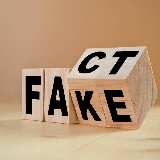|
|
| |
|
|
| |
|
|
|
|
| |
 Lesson
1: Real News vs. Fake News Lesson
1: Real News vs. Fake News
The lesson includes a video program, the text for the
video
program, and a words in this story section. |
|
|
|
Lesson 1: Real News vs. Fake News
Watch the video program about this lesson.
Then read the text and the words in this story section. |
|
|
Lesson 1: Real News vs. Fake
News |
Information is an important part of our society. People
depend on it to guide them through a complex world.
The invention of movable type in 15th century Europe
revolutionized the communication of ideas. This
invention made it possible to print and publish
information to masses of people
This free flow of information eventually led to a free
press in many parts of the world. But because
information is so powerful, many world leaders have
tried to stop it.
French leader Napoleon Bonaparte once said he feared
four newspapers more than 1,000 bayonets.
The Chinese emperor who oversaw the building of the
Great Wall famously used his power to stop published
information. Qin Shi Huang ordered the burning of
thousands of books on subjects he wanted to keep from
the people. He even had hundreds of scholars executed
for refusing to give up their book collections.
Even powerful leaders in modern times have succeeded in
blocking material they do not want the people to see, as
in Russia and China.
But when true information is allowed to reach the
people, good results can follow. Information has fueled
successful revolutions in many nations. Government
atrocities have been identified and world leaders have
been forced to be held accountable for their actions.
Advances in media technology have made words and images
more powerful and widespread than ever. Smartphones and
social media have become quick and easy tools to receive
and share news and information. These tools have even
made it possible for anyone with a device to gather and
publish “news.”
This media environment makes it important for us to be
able to recognize reliable information. True information
gives us the facts to guide our decisions and actions.
In addition to informing, news can also divert.
This means it can focus our attention on something we
are interested in as a kind of escape. An example would
be news about subjects we seek out for enjoyment, such
as entertainment, celebrities or sports.
News can also serve as a way to connect us as human
beings. This could include stories about tragedies or
uplifting events that affect us emotionally. Such
stories can lead people to join a cause or donate money
to help those in need.
No matter what kind of news we experience, we have to be
able to tell whether it is authentic or not. In the
coming lessons, we will show you the steps; how you can
do this.
This lesson is based on the News Literacy class at the
Center for News Literacy at Stony Brook University. For
more on how to become a news literate citizen, go to The
Center for News Literacy. |
|
|
Words in This Story |
- type
- n. standardized
letters for printing
- masses
- n. large groups of
people
- bayonet
- n. Knife at the end
of a rifle
- atrocity
- n. a cruel and
terrible act
- device
- n. an item, such as
mobile phone or radio
- reliable
- adj. can be trusted
to do the correct thing
- divert
- v. to change
direction, or move one's attention
|
|
Source: Voice of America |
|
|
|
|
|
|
|
|
|
|
|
|
|
|
|
|
Search Fun Easy English |
|
|
|
|
|
|
|
|
|
|
|
|
|
|
|
About
Contact
Copyright
Resources
Site Map |